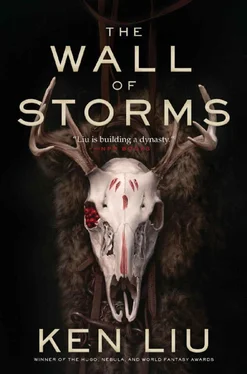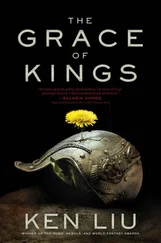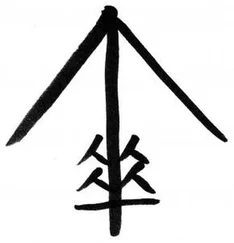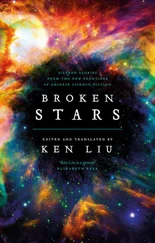“You make me sound like an insecure and jealous wife. I know what I have done for the House of Dandelion.”
“Puma Yemu’s contributions were also great, Gin, but Kuni didn’t even intervene to give him a chance to save face when Jia humiliated him. If you cannot sense the shifting winds—”
“I am not Puma Yemu.”
“This is a clumsy move, Gin. It will not end well.”
Gin flopped carelessly onto the bed. “We’ll speak no more of this. Come and join me. Let’s see if you’ve stayed in shape after five years of drifting about in a balloon.”
Luan sighed, but he obediently came to bed.
CHAPTER FOUR
GRAND EXAMINATION
PAN: THE SECOND MONTH IN THE SIXTH YEAR OF THE REIGN OF FOUR PLACID SEAS.
The Examination Hall was a breathtaking sight.
The hall was one of the only cylindrical buildings in the Harmonious City, with a diameter of about four hundred feet. Built atop the old site of Mapidéré’s Imperial armory, right outside the walls of the new Imperial palace, it was about as tall as one of the watchtowers of the city, and concentric circles of gilt shingles on the roof gleamed in the sun, making the building appear as a gigantic blossom—some claimed they saw a chrysanthemum; others a dandelion.
The building also served as the centerpiece of the academic quarter of the city, which, in addition to the Examination Hall itself, consisted of the Imperial Academy, where the firoa —those who had passed the Grand Examination by scoring within the top one hundred of all candidates—could pursue in-depth study with specialists in various subjects; the Imperial Observatory, where astronomers surveyed the stars and divined the fate of Dara; the Imperial laboratories, where renowned scholars conducted research in various fields; and the neat rows of dormitories and individual houses for resident and visiting scholars.
After ascending to the throne, Emperor Ragin had made scholarship a centerpiece of his plan for rebuilding Dara, and Pan was now growing to rival Ginpen in Haan as a center of learning. Those who distinguished themselves in the examinations could serve the emperor through posts in civil administration or by exploring and extending the frontiers of knowledge.
The inside of the Examination Hall was airy and open, as the interior was simply one large, high-ceilinged, circular room. Multiple rows of windows honeycombing the top half of the cylindrical wall and a massive, eyelike skylight in the center bathed the interior in sunlight. The floor was divided into concentric rings of stalls by eight-foot-tall partitions for the test takers, with a capacity close to two thousand. At the center of the hall was a tall pillar that raised a platform into the air, just below the ceiling, like the crow’s nest on a ship. The examination administrators sat on this platform, where they had a panoptic view of the proceedings to detect cheating. Halfway up the wall, above the test takers but below the administrators’ platform, was an elevated walkway that went all the way around the hall for the patrolling proctors, adding further security.
As the sun rose over the walls of the palace, Duke Rin Coda, Imperial Farsight Secretary, looked over to Cogo Yelu, Prime Minister, who sat next to him on the central platform.
“Back when we were all in Zudi, did you ever think a day would come when the best and brightest of Dara would have to answer one of your questions and follow my directions if they wished to advance?” Rin asked.
Cogo smiled placidly. “I think it’s best not to dwell on the past. This day is about the future.”
Chagrined, Rin turned back to face the entrance of the Examination Hall and intoned, “Open the doors!”

The cashima came from every corner of Dara: the fabled ancient academies of Ginpen, whose walls and porticos were draped with ivy and morning glory; the open-air schools of Müning, where lecturers and pupils roamed from hanging platforms to flat-bottomed boats floating over the sparkling waters of Lake Toyemotika; the fog-shrouded forums of Boama, where teachers and students debated ideas in the morning before heading to the sheep pastures for exercise and leisure; the hamlets scattered in the Ring-Woods surrounding Na Thion, where solitary scholars contemplated nature and art; the gleaming, grand, and richly furnished classrooms of Toaza, where cosmopolitan attitudes mixed with commercial purpose; the stone-walled learning halls of Kriphi, where ancient virtues were extolled to dull the pain of recent suffering; the private knowledge gymnasiums of Çaruza, where straw mats lined the floor so that students could study books as well as the martial arts of wrestling, boxing, and swordsmanship.
They were the best students in all of Dara. Emperor Ragin’s system, devised by Prime Minister Cogo Yelu and Imperial Tutor Zato Ruthi, was a continuation and refinement of the ancient examination systems developed in the various Tiro states and under the Xana Empire. With standardized questions and uniform scoring systems, the goal of the Imperial examinations was to filter and sieve all the talent that Dara had to offer and bring forth the best to serve the emperor, regardless of the examinees’ origins.
Every year, students from across Dara took part in the annual Town Examinations in the nearest large town. Answering questions on a variety of subjects from astronomy and literature to mathematics and aquatic and terrestrial zoology, those who passed earned the rank of toko dawiji . Out of a hundred students who took the exams, perhaps no more than ten or twenty accomplished this feat.
Then, every two years, the toko dawiji took part in the Provincial Examinations, in which the scholars had to compose essays on various topics. The essays were judged on criteria such as erudition, insight, creativity, use of evidence, and beauty of calligraphy. Out of a hundred toko dawiji , perhaps no more than two or three would pass and obtain the rank of cashima .
Finally, every five years—and this would be the first time since the founding of the Dandelion Dynasty—the cashima of each province and fief gathered at the regional capital and were selected to participate in the Grand Examination. Since each fief or province was allocated only a limited number of passes, the governor or king or duke or marquess would have to pick the attendees based on their test scores, character, recommendations, presentation, and a host of other factors. The selected cashima , the cream of the crop, gathered in Pan.
All of them had been preparing for this moment for years, some for the entirety of their lives. Some had passed the Provincial Examinations on their first try; others had tried multiple times during the days of the Tiro kings and under the Xana Empire without success, and then, as the rebellion and the Chrysanthemum-Dandelion War interrupted all examinations, did not get another chance until their hair had turned white. Their journeys here had been long and arduous, far more than just a ride in a bumpy carriage or a voyage across the sea, consisting also, as they did, of long hours spent poring over the scrolls of the Ano Classics and volumes of commentary codices, and the deprivation of the joys of youth, the lazy summers as well as the idle winters.
The dreams of entire families hung on them: Nobles who had won their titles by the sword and horse hoped their descendants would add honor to those titles with the writing knife and brush; merchants who had amassed vast fortunes sought the cloak of respectability made possible only by a learned offspring in Imperial service; fathers who had failed in their own pursuit of glory desired to see those dreams redeemed by their sons; clans who hoped to leap out of obscurity pooled their resources to support a single, brilliant child. Many had paid expensive tutors who claimed to know the secret of writing the perfect essay, and even more had paid charlatans who sold crib sheets and cram notes that were as expensive as they were useless.
Читать дальше













